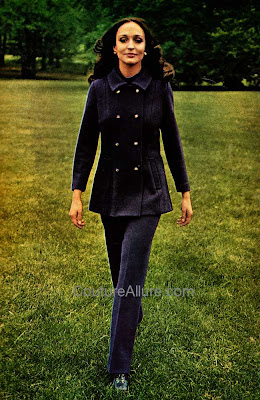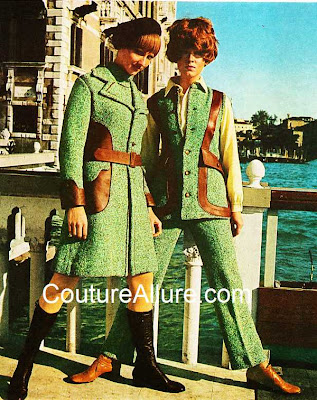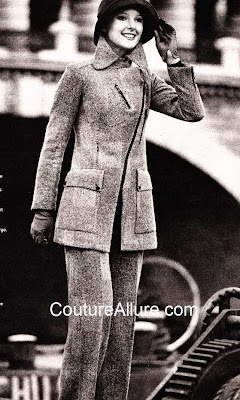 This week, we've looked at suits in the 1940s, 1950s, and 1960s. I'm going to close out the week with a look at the late 60s into the mid 70s. Fashion changed radically at this time, and it started with the Youthquake movement in London. In the above photo from 1965, you can see how different this Biba suit is from the suits I showed yesterday. Not only is the jacket much longer, but it has pants instead of a skirt! Pants had been fine for casual wear up to now, but they were not worn by women for business, streetwear, or dressier occasions.
This week, we've looked at suits in the 1940s, 1950s, and 1960s. I'm going to close out the week with a look at the late 60s into the mid 70s. Fashion changed radically at this time, and it started with the Youthquake movement in London. In the above photo from 1965, you can see how different this Biba suit is from the suits I showed yesterday. Not only is the jacket much longer, but it has pants instead of a skirt! Pants had been fine for casual wear up to now, but they were not worn by women for business, streetwear, or dressier occasions. Over the next 4 years, the ideas from young London designers began to take hold on the Paris runways and in American fashion. Here you can see clearly that jacket lengths have nose-dived to the hips or below, sleeves are full length again, and pants are acceptable. And while we don't see the sculpted tiny waists of the 40's and 50's, there is a bit of shaping in the jacket.
Over the next 4 years, the ideas from young London designers began to take hold on the Paris runways and in American fashion. Here you can see clearly that jacket lengths have nose-dived to the hips or below, sleeves are full length again, and pants are acceptable. And while we don't see the sculpted tiny waists of the 40's and 50's, there is a bit of shaping in the jacket. Skirts were shorter in length, and suits were often made of unusual fabrics with wild prints or textures. Here velveteen is used for a day suit. Jackets are often belted to shape the waist.
Skirts were shorter in length, and suits were often made of unusual fabrics with wild prints or textures. Here velveteen is used for a day suit. Jackets are often belted to shape the waist. The convention of a suit having of a jacket on top is gone, and we see it replaced with vests, tunics, and coats.
The convention of a suit having of a jacket on top is gone, and we see it replaced with vests, tunics, and coats. By 1972, skirt lengths are all over the map, with minis, midis, and maxis offering women freedom of choice.
By 1972, skirt lengths are all over the map, with minis, midis, and maxis offering women freedom of choice. Jackets remain longer and collars are huge.
Jackets remain longer and collars are huge. In the early 70's plaid is everywhere, and using a large scale, brightly colored plaid on top and bottom is not too much.
In the early 70's plaid is everywhere, and using a large scale, brightly colored plaid on top and bottom is not too much. By the mid-1970's, the use of knits has made tailoring less necessary. Jackets are soft and belted for shape, and are often unlined.
By the mid-1970's, the use of knits has made tailoring less necessary. Jackets are soft and belted for shape, and are often unlined.I hope you've enjoyed this short history of suits. Hopefully, when you find a vintage suit, these posts will help you identify when it was made.
0 comments:
Post a Comment